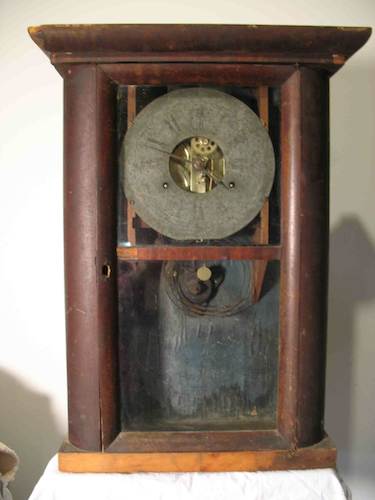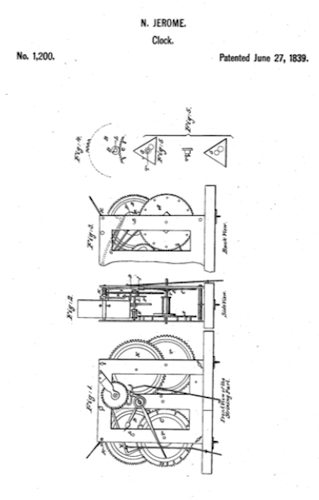 The clock in as found condition (except for the movement, which was cleaned before taking this picture). The card label is missing, but the four holes in the backboard where the label was tacked on are still present. Glasses appear to be original, although they’ve been stripped down to bare glass. The upper one still has remnants of black paint. It’s not clear whether the lower glass was originally reverse-painted or a mirror. The case, at 21 inches, is an inch shorter than its taller cousin but is wider across the top of the cornice (15.5 inches vs. 15 inches for the taller version).
The clock in as found condition (except for the movement, which was cleaned before taking this picture). The card label is missing, but the four holes in the backboard where the label was tacked on are still present. Glasses appear to be original, although they’ve been stripped down to bare glass. The upper one still has remnants of black paint. It’s not clear whether the lower glass was originally reverse-painted or a mirror. The case, at 21 inches, is an inch shorter than its taller cousin but is wider across the top of the cornice (15.5 inches vs. 15 inches for the taller version).
This clock has been discussed in NAWCC Bull. 398 (July/August 2012), p. 432 and Watch & Clock Bull. 403 (May/June 2013), p. 323-324.
Type 1.113 Noble Jerome patent movement. All gears, except for the escape wheel and #1 strike wheel, are solid (no spokes). Snowden Taylor revised the numbering for these early patent movements in 2013 (Watch & Clock Bull., Whole No. 403, Vol. 55/3, May/June 2013, p. 320-324), because greater variability has been evident as more of them have come to light. This version was formerly considered type 1.112.
Type 1.113 Noble Jerome patent movement (back), showing spoked #1 strike wheel.
Patent #1200, issued to Noble Jerome June 27, 1839. Production of these movements started the year before the patent was issued. The patent application was submitted from Hamburg, South Carolina (now North Augusta). The Jeromes retailed clocks in Hamburg through L.M. Churchill & Co.


